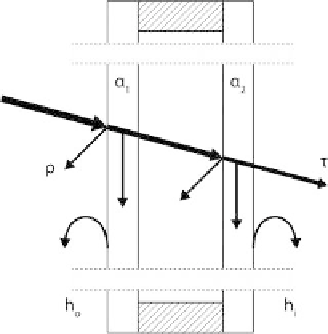Environmental Engineering Reference
In-Depth Information
Figure 18.3.1
Transmission
τ
, reflection
ρ
, absorption
α
and heat transfer coefficients at the inside (h
i
)
and outside (h
o
) of a double-glazing.
solving heat balance equations. The degrees of transmission, absorption and reflection
must be known for each pane of a multi-pane system. The total energy transmission
factor then results from the relation of the total heat flow
Q
total
/A
w
into the room to
the irradiance:
Q
total
/A
w
G
Q
i
/A
w
G
+
τG
=
=
=
+
g
τ
q
i
(18.3.1)
The transmittance
τ
is calculated based on EN 410 by integration of the wavelength-
dependent transmission over the solar spectrum. With perpendicular incidence,
transmittance is approximately 90% for an uncoated simple float glass and about
80% for a two-pane system. Transmittance falls and the total energy transmission fac-
tor of the two-pane system rarely exceeds 65% due to the metallic coating in thermally
insulating glazing commonly used today on the room-side panes. The absorption factor
α
of the short-wave solar radiation is similarly calculated for each pane by integration
over the spectrum, taking into account inter-reflections in multi-pane systems.
The solutions of the heat balance equations for single, double and triple glazing
are indicated in EN 410. Using the example of single glazing, a heat balance is shown
in Figure 18.3.2 and can be described as follows: the intensity
αG
absorbed by the
pane of surface
A
w
is divided into a heat flow inward
Q
i
/A
w
and outward
Q
o
/A
w
.
Q
i
A
w
+
Q
o
A
w
αG
=
(18.3.2)
These heat flows can be calculated with the help of the heat transfer coefficients
h
i
(stan-
dard value 7.7 W m
−
2
K
−
1
) and
h
o
(standard value 25 W m
−
2
K
−
1
), and the temperature



Search WWH ::

Custom Search